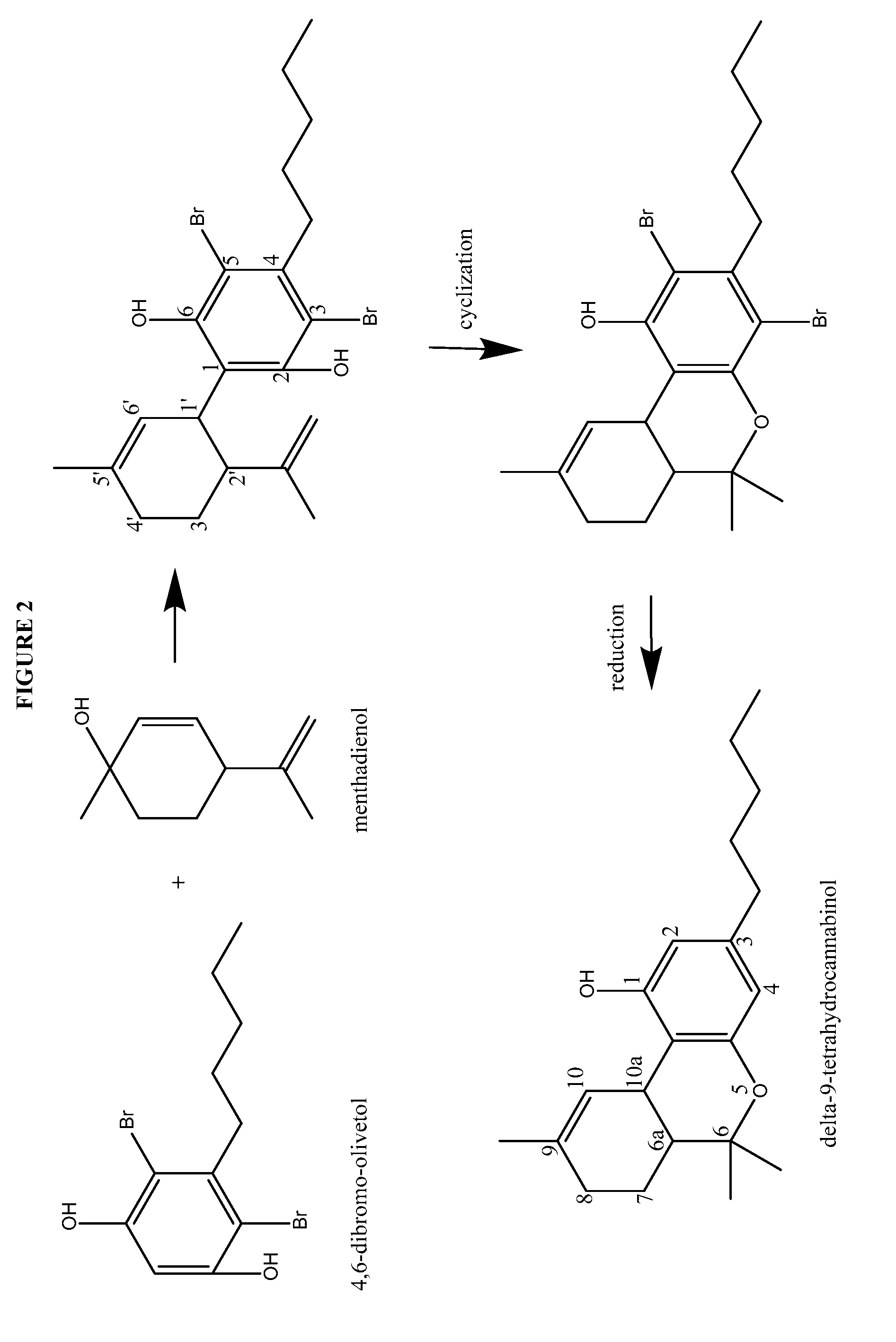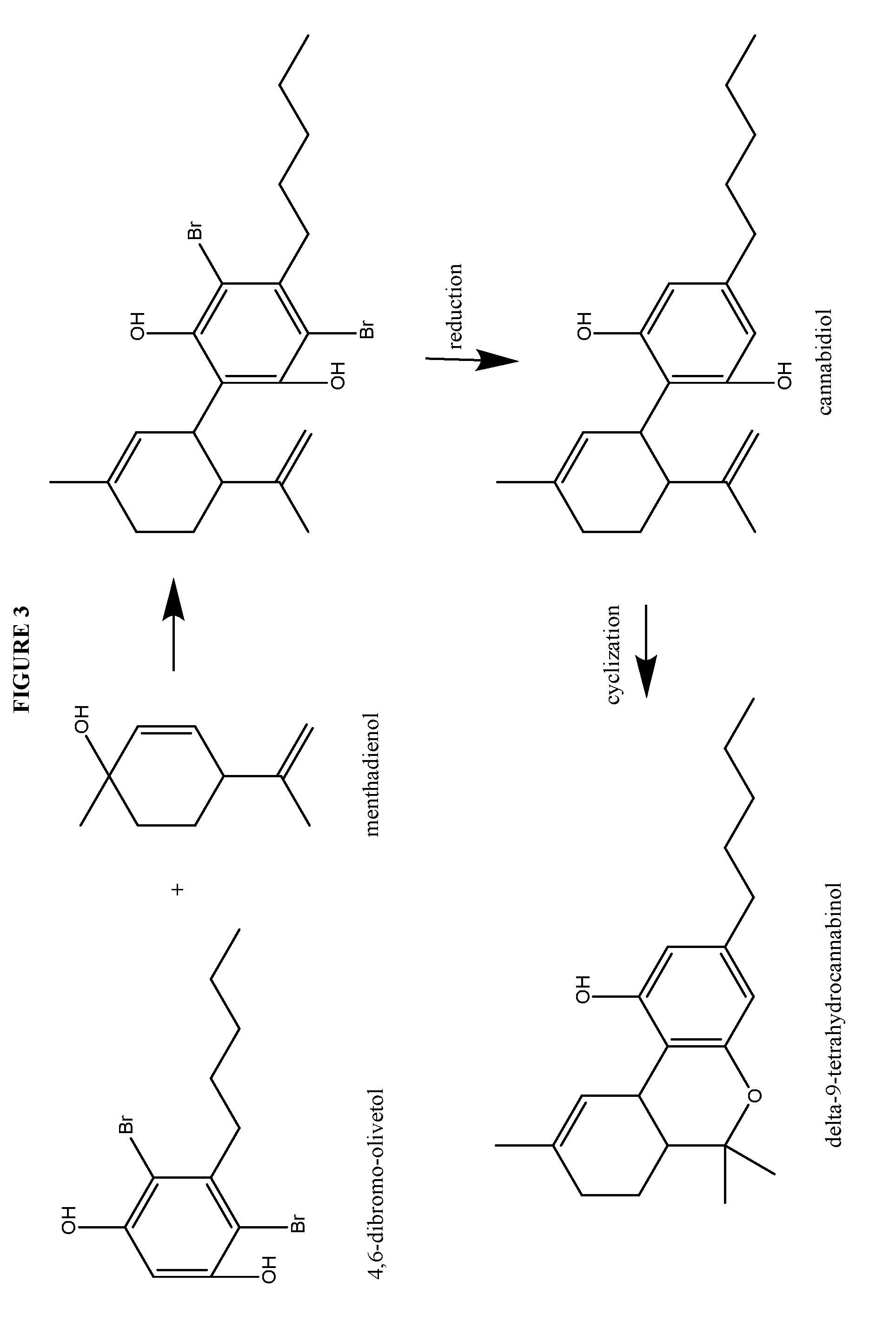Process for the production of cannabidiol and delta-9-tetrahydrocannabinol
a technology of delta-9-tetrahydrocannabinol and cannabidiol, which is applied in the field of preparation of cannabidiol compounds or derivatives, can solve the problems of difficult or impossible separation and purification, formation of significant amounts of unwanted cannabidiol isomers along with cannabidiol, etc., and achieves low yield, poor selectivity, and high yield.
- Summary
- Abstract
- Description
- Claims
- Application Information
AI Technical Summary
Benefits of technology
Problems solved by technology
Method used
Image
Examples
example 1
Synthesis of Cannabidiol from 4,6-dibromo-Olivetol
[0211]Cannabidiol, or (1′R,2′R)-5′-methyl-4″-pentyl-2′-(prop-1-en-2-yl)-1′,2′,3′,4′-tetrahydro-[1,1″-biphenyl]-2″,6″-diol, was prepared according to the present disclosure.
[0212]Under a N2 atmosphere, 4,6-dibromo-olivetol (20.08 g, 59.40 mmol), magnesium sulfate (20.00 g, 164.5 mmol, 2.77 equiv.) and para toluene sulfonic acid monohydrate (5.76 g, 29.8 mmol, 0.50 equiv.) were suspended in CH2Cl2 (187.4 g) and cooled to between about −15 to −20° C. To this white suspension a clear solution of menthadienol (11.72 g, 76.99 mmol, 1.30 equiv.) in CH2Cl2 (55.13 g) was added dropwise over 6 hours. After stirring overnight at −15° C., the suspension was quenched with water (200.6 g). NaHCO3 (5.01 g, 59.6 mmol, 1.00 equiv.) was added in portions and the mixture was stirred for about 10 to 30 min at room temperature. The layers were separated and the aqueous layer was re-extracted with CH2Cl2 (50.1 g). The organic layer was concentrated to dry...
example 2
Variation of the Chain Length (C3H7 and C5H11)
[0215]Synthesis of C3-olivetol analogue: The C3-analog of olivetol was synthesized, starting from commercially available 3,5-dimethoxybenzoic acid as shown in FIG. 4. The synthesis of 3,5-dimethoxybenzoyl chloride [1] was first tested on a 1 g scale by the treatment of 3,5-dimethoxybenzoic acid with 1.2 eq. of SOCl2 in toluene at 100° C. The reaction proceeded smoothly and after 1 hour, a complete conversion was observed on LC-MS. The solvents were evaporated and the product was stripped twice with toluene to remove the excess SOCl2 to yield 1.15 g of [1] (quantitative yield), which was used as such in further experiments. Repetition of the reaction on 95 g scale was performed and yielded a second batch of [1] (110 g, quantitative yield).
Synthesis of 3,5-dimethoxybenzoyl chloride [1]
[0216]
[0217]To a suspension of 3,5-dimethoxybenzoic acid (95 g, 521 mmol) in toluene (dry, 950 mL) was added thionyl chloride (74.4 g, 626 mmol, 45.4 ml) and...
example 3
Generality of Di-Halo Protection of Olivetol
[0234]The use of bromide, chloride and iodide was investigated as providing di-halo protection to 5-propylbenzene-1,3-diol [5], the C3-olivetol analogue.
[0235]Adding bromide as protection group: The bromination of [5] towards 4,6-dibromo-5-propylbenzene-1,3-diol [6] was performed as shown in FIG. 5. At −30° C., a solution of 0.25 g of [5] in 6 ml DCM was treated with 2.0 eq. of bromine. During cooling of the initial starting material solution, a sticky oil had formed at the bottom of the flask which hindered proper stirring. Also, the bromine was added using a syringe. The low temperature inside the reaction flask caused the bromine to solidify in the needle and blocked it. In a subsequent experiment, a bigger stirring magnet was used and the bromine was added as a solution in DCM using a dropping funnel in 10 minutes. After stirring for an additional 10 minutes, the reaction mixture was poured into a cold aqueous sodium thiosulfate soluti...
PUM
 Login to View More
Login to View More Abstract
Description
Claims
Application Information
 Login to View More
Login to View More - R&D
- Intellectual Property
- Life Sciences
- Materials
- Tech Scout
- Unparalleled Data Quality
- Higher Quality Content
- 60% Fewer Hallucinations
Browse by: Latest US Patents, China's latest patents, Technical Efficacy Thesaurus, Application Domain, Technology Topic, Popular Technical Reports.
© 2025 PatSnap. All rights reserved.Legal|Privacy policy|Modern Slavery Act Transparency Statement|Sitemap|About US| Contact US: help@patsnap.com



